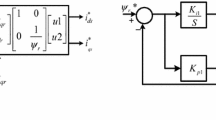Abstract
The parameters selection of proportional coefficient and integral coefficient (PI) for speed controller is important for direct torque control system. However, it is difficult to adjust these parameters. In this paper, firstly, we use particle swarm optimization to search the appropriate PI values of the speed controller. Secondly, based on the optimized PI parameters, the fuzzy-PI speed control strategy is presented to solve the poor self-adaptability problem. Thus, the proportional coefficient k p and integral coefficient k i can be adjusted dynamically to adapt to the speed variations. And finally, to obtain the high-speed parallel processing ability, the well-trained RBF neural network replaces the fuzzy-PI speed controller. The comparison with conventional PI speed controller shows that the proposed intelligent integrated speed controller brings good benefits of fast speed response and good stability and reduces the torque ripple. The validity of the proposed intelligent integrated speed controller is verified by the simulation results.









Similar content being viewed by others
Explore related subjects
Discover the latest articles, news and stories from top researchers in related subjects.References
Depenbrock M (1988) Direct self-control of inverter-fed induction machine. IEEE Trans Power Electron 3:420–429
Takahashi I, Noguchi T (1986) A new quick-response and high-efficiency control strategy of an induction motor. IEEE Trans Ind Appl IA-22(5):820–827
Chen P-Y, Wu C-J, Fu Y-Y, Ko C-N (2009) A PSO method with nonlinear time-varying evolution for optimal design of PID controllers in a pendubot system. Artif Life Robot 14:58–61
Le M-D, Nguyen S-H, Nguyen L-A (2004) Study on a new and effective fuzzy PID ship autopilot. Artif Life Robot 8:197–201
Paladugu A, Choedhury BH (2007) Sensorless control of inverter-fed induction motor drives. Electr Power Syst Res 77:619–629
Huh SH, Park JH, Choy I, Park GT (2004) Nonlinear uncertainty observer for AC motor control using the radial basis function networks. IEEE Proc Control Theory Appl 151(3):369–375
Lin FJ, Shieh PH, Hung YC (2008) An intelligent control for linear ultrasonic motor using interval type-2 fuzzy neural network. IET Electr Power Appl 2(1):32–41
Liang D, Ding W (2009) Modeling and predicting of a switched reluctance motor drive using radial basis function network-based adaptive fuzzy system. IET Electr Power Appl 3(3):218–230
Teng LT, Lin FJ, Chiang HC (2009) Recurrent wavelet neural network controller with improved particle swarm optimization for induction generator system. IET Electr Power Appl 3(2):147–159
Yeh MF, Tsai CH (2010) Standalone CMAC control system with online learning ability. IEEE Trans Syst Man Cybern B 20(9):1377–1384
Clerc M, Kennedy J (2002) The particle swarm-explosion, stability, and convergence in a multidimensional complex space. IEEE Trans Evol Comput 6(1):58–73
Yang X, Zheng J (2003) Artificial neural network and blind signal processing (M). Tsinghua University Press, Beijing
Author information
Authors and Affiliations
Corresponding author
About this article
Cite this article
Xu, K., Liu, S. & Wang, X. The intelligent integrated speed controller of DTC for induction motor. Artif Life Robotics 19, 33–39 (2014). https://doi.org/10.1007/s10015-013-0127-8
Received:
Accepted:
Published:
Issue Date:
DOI: https://doi.org/10.1007/s10015-013-0127-8




